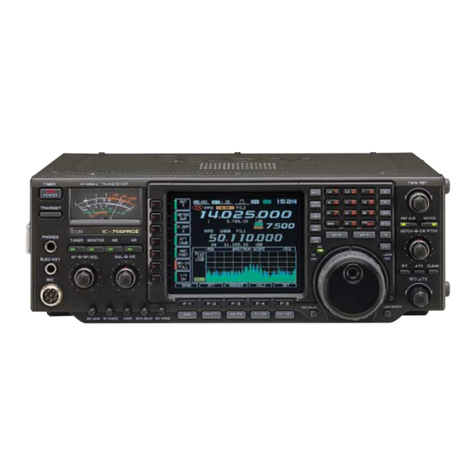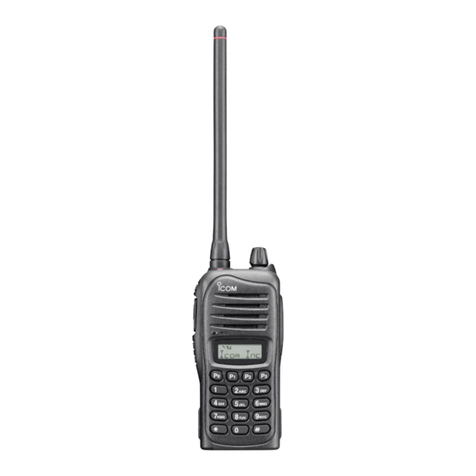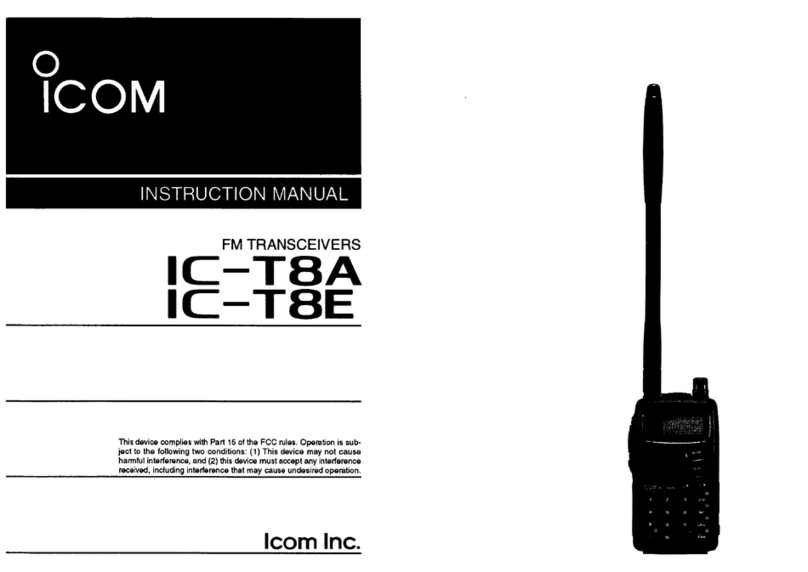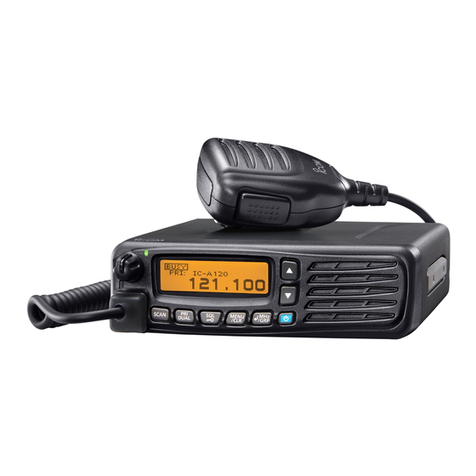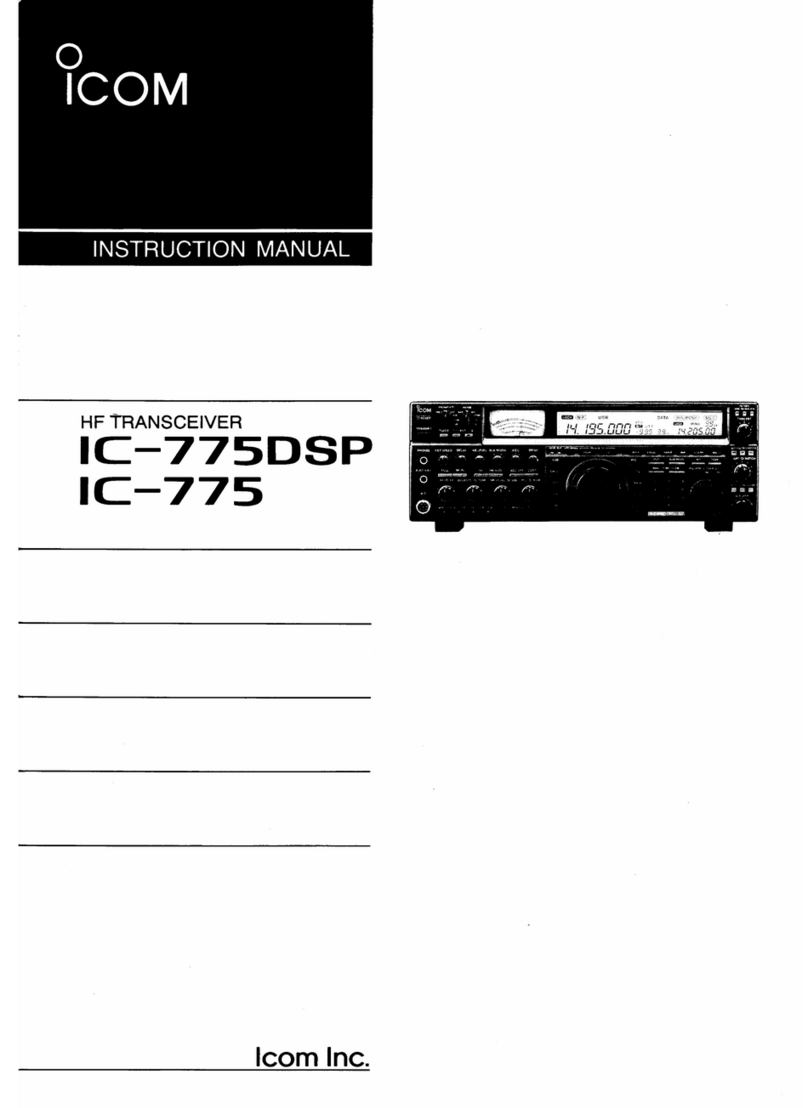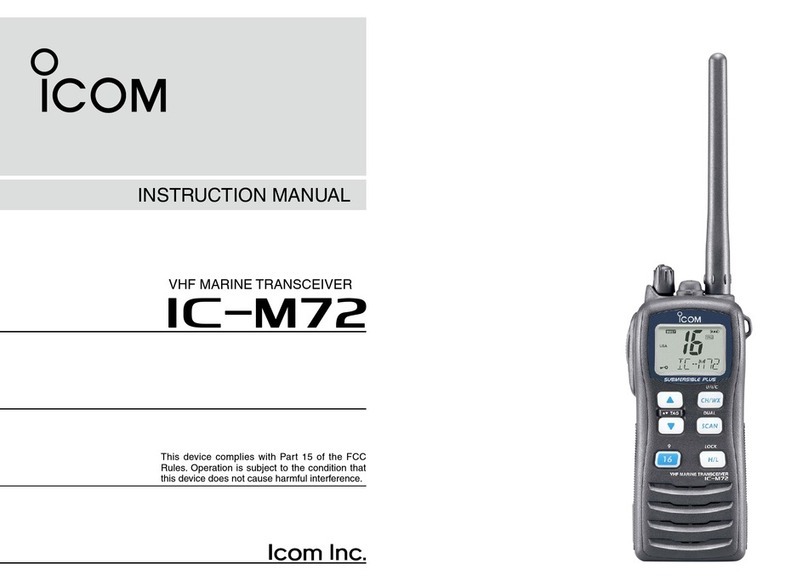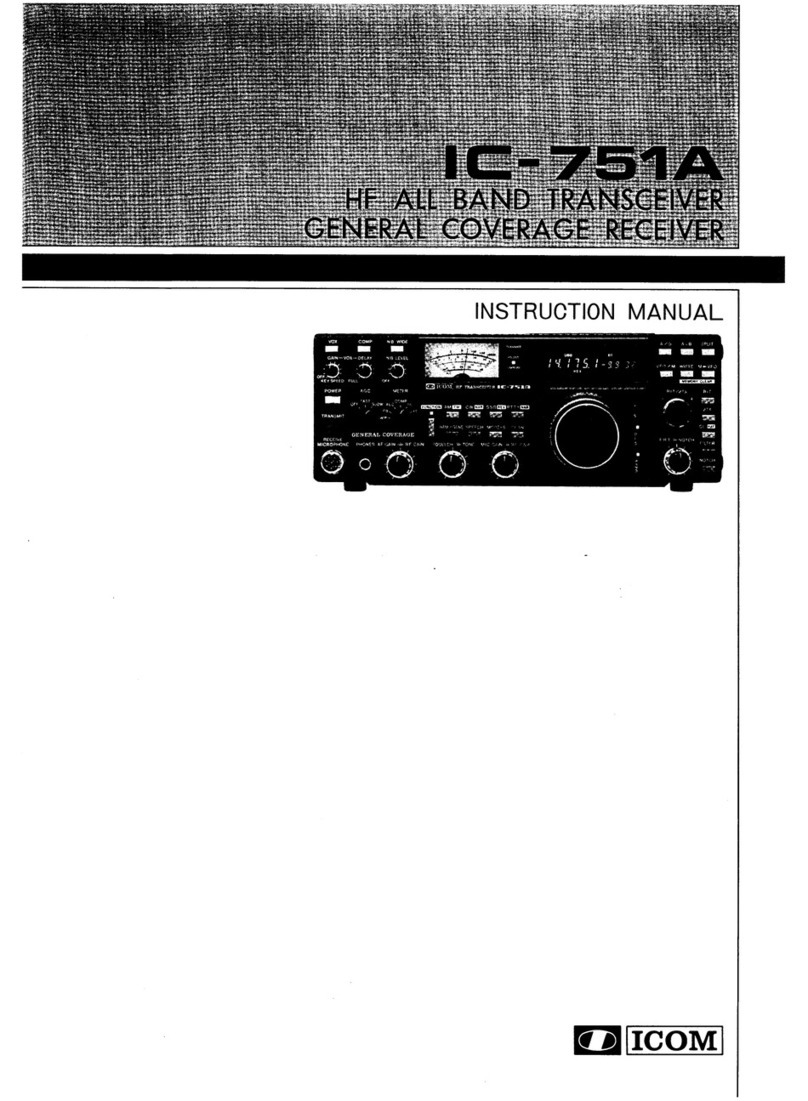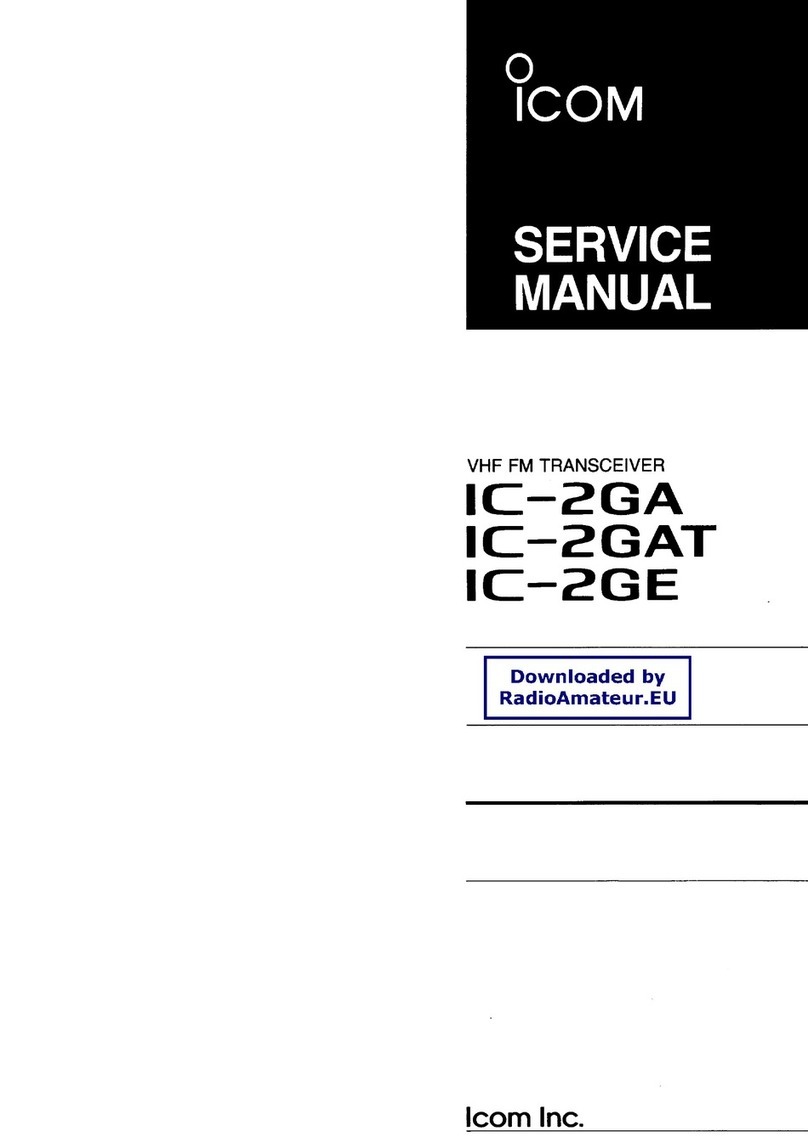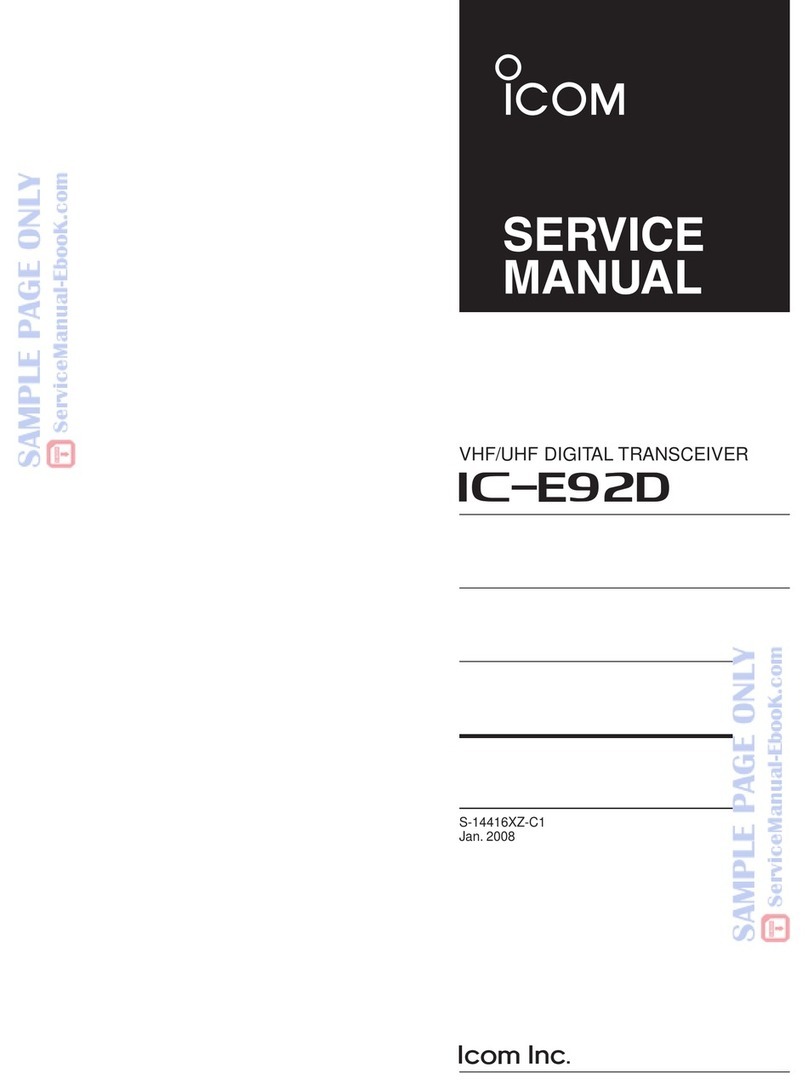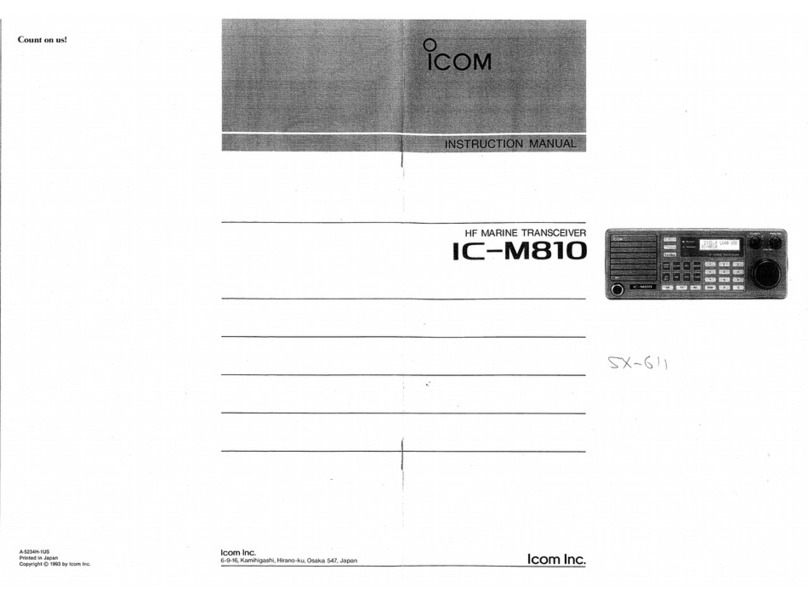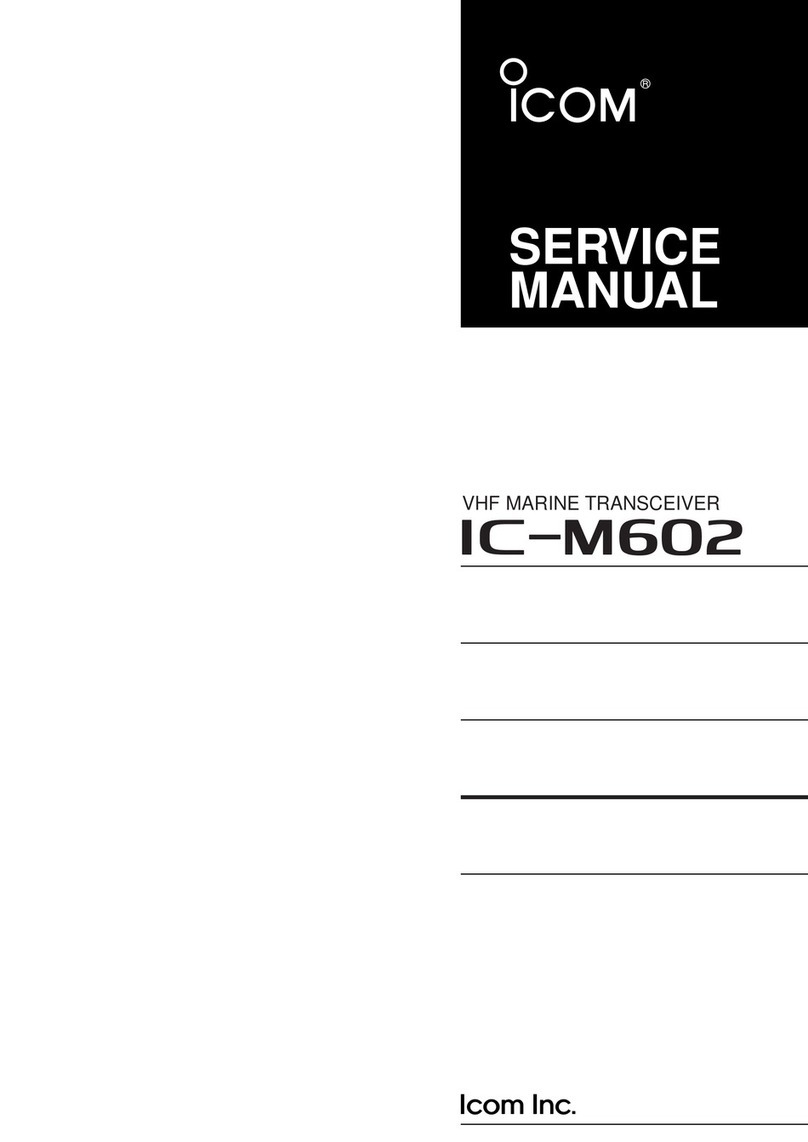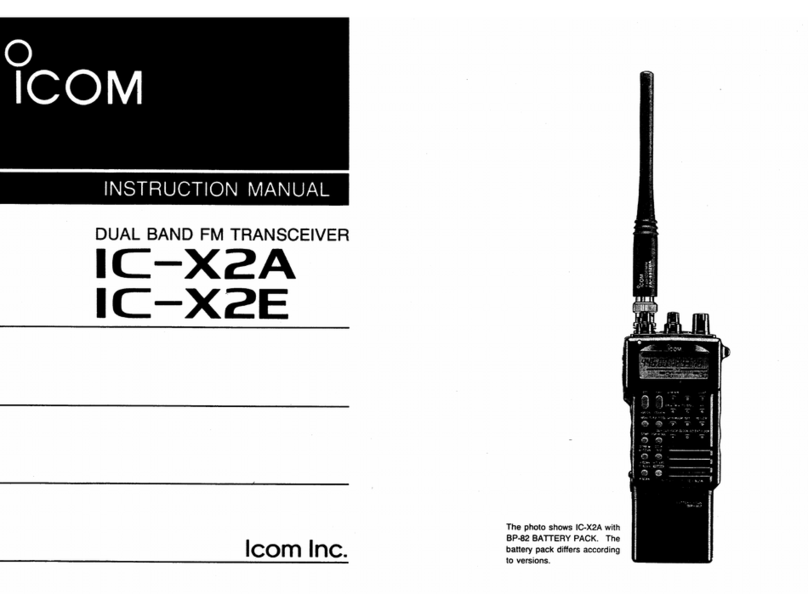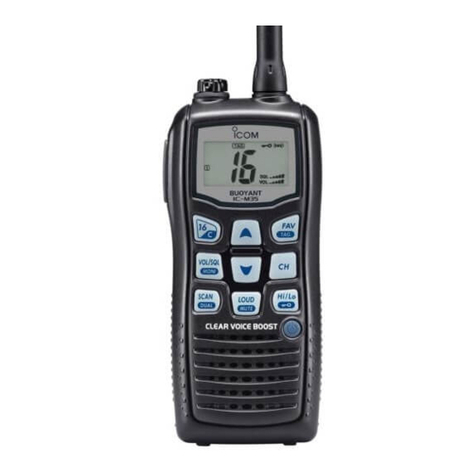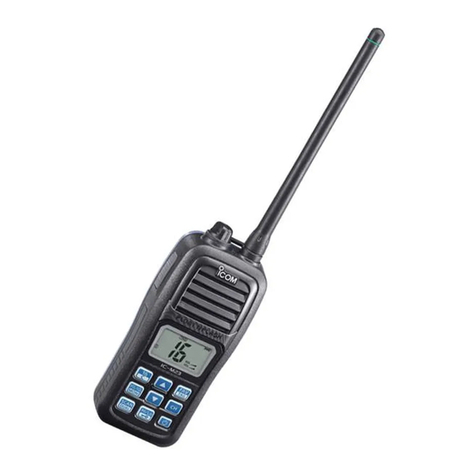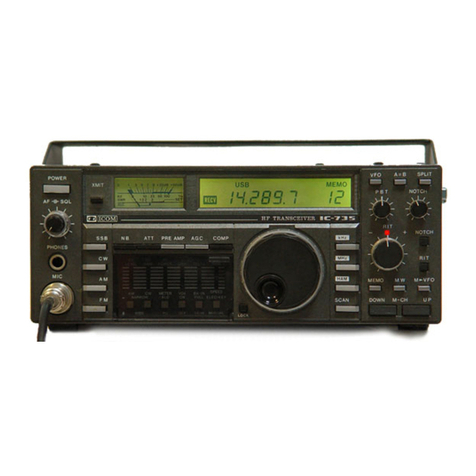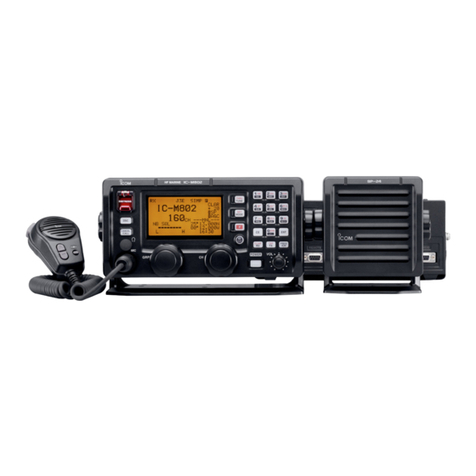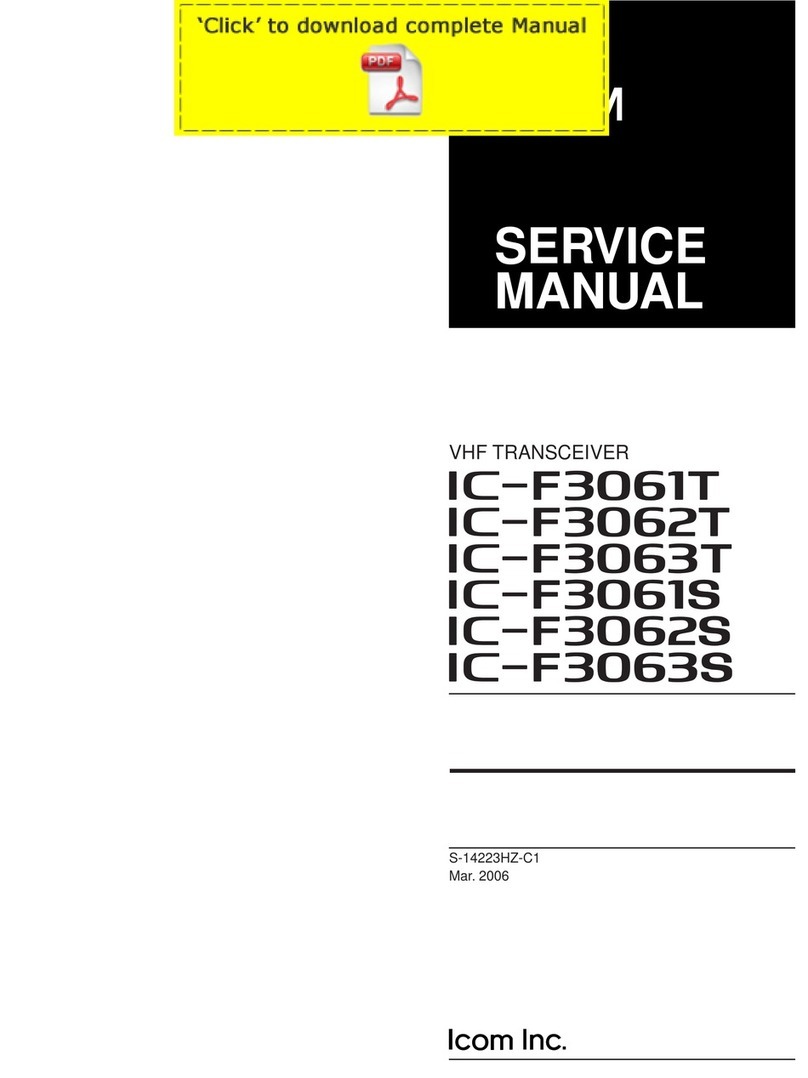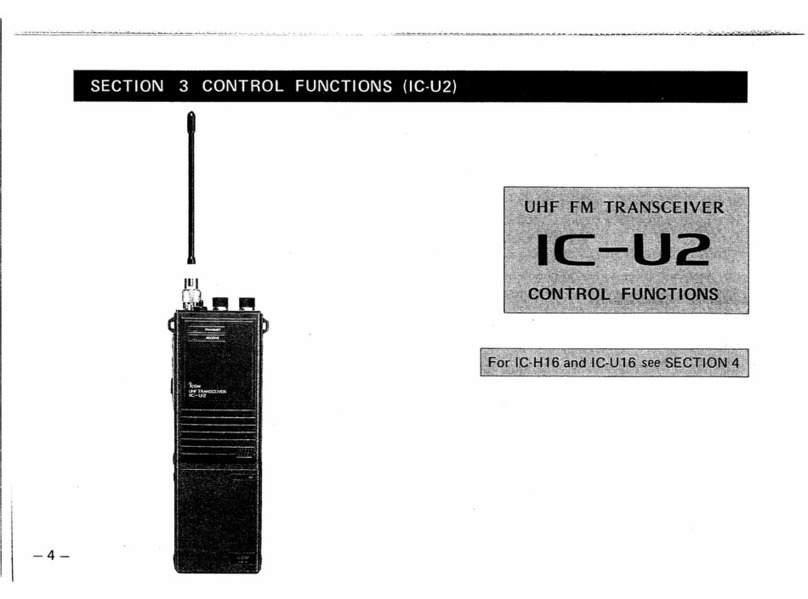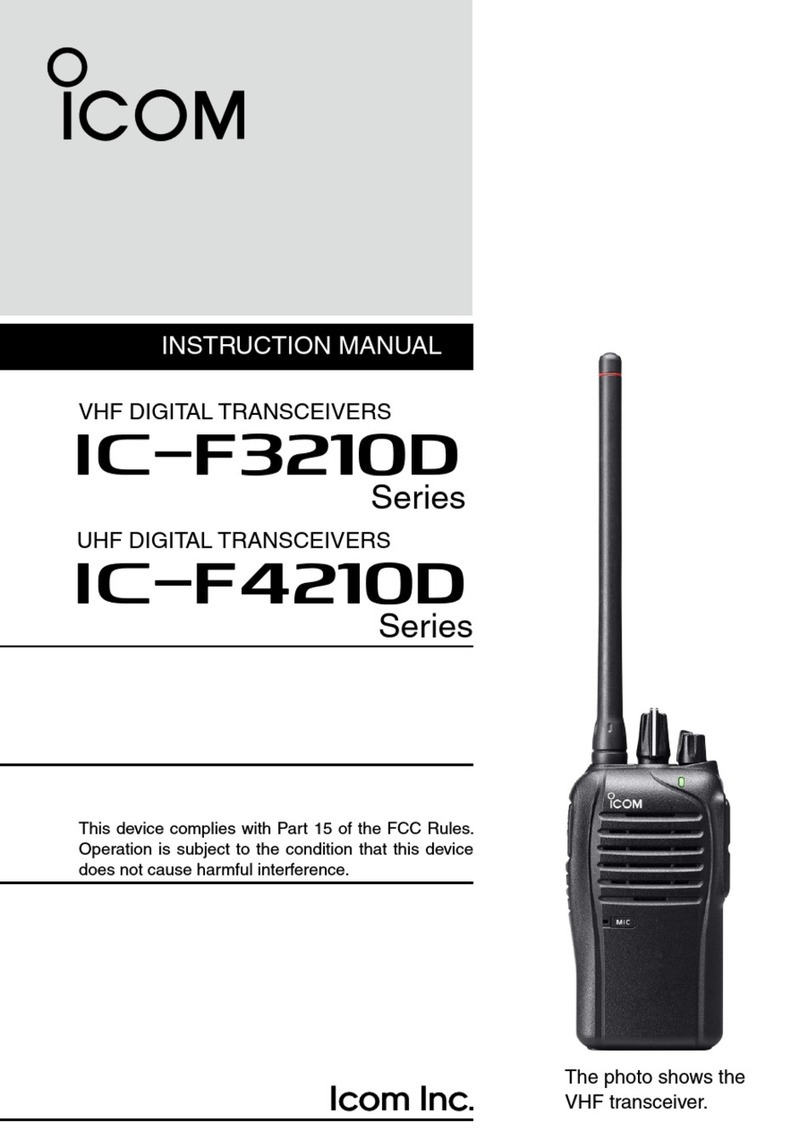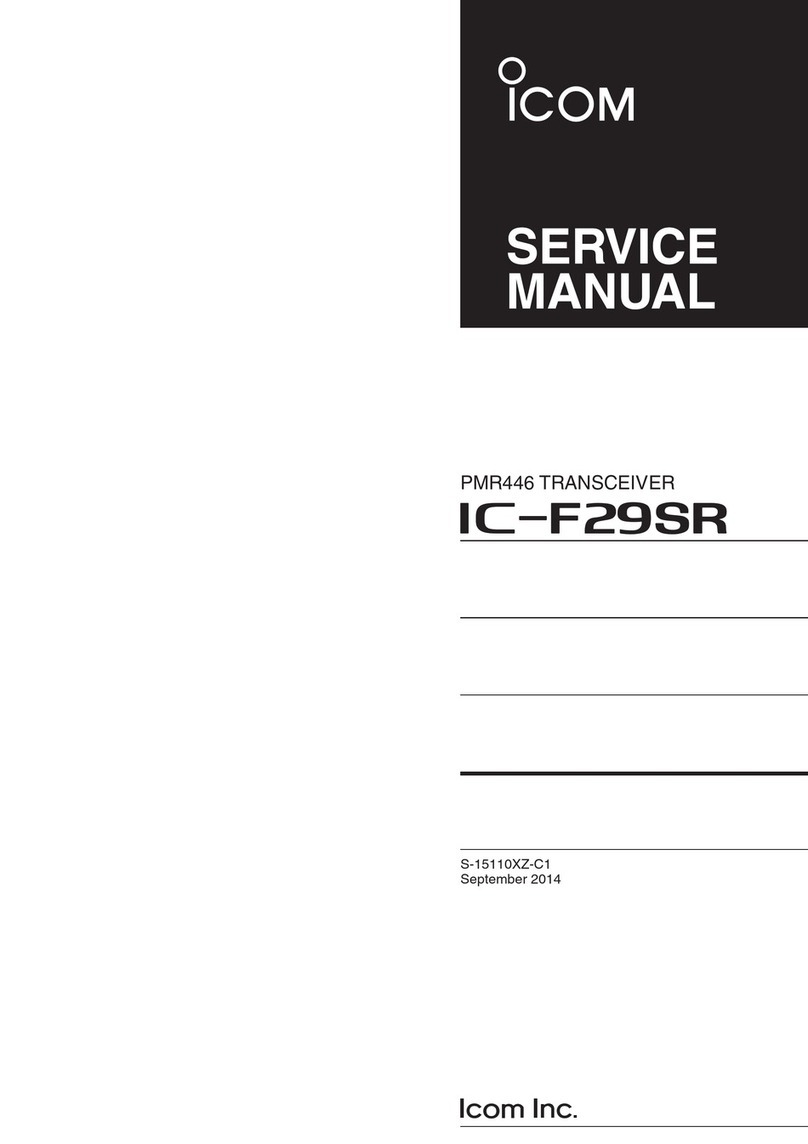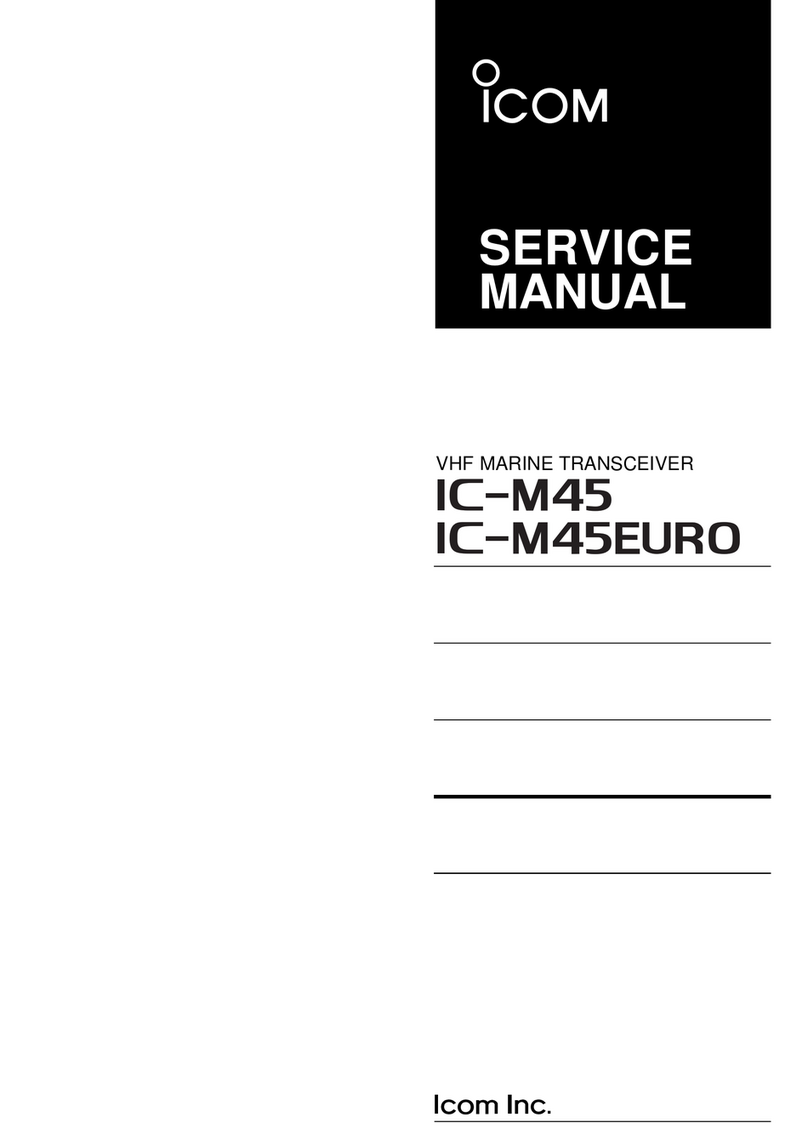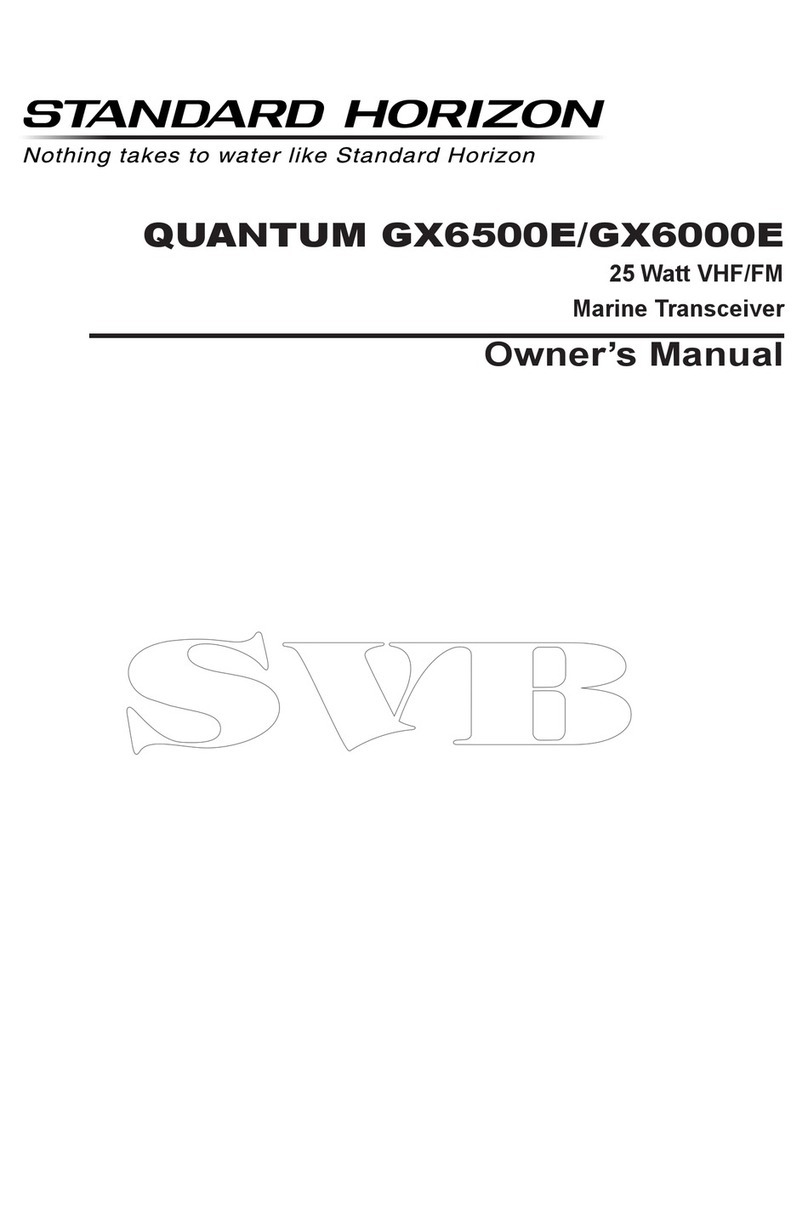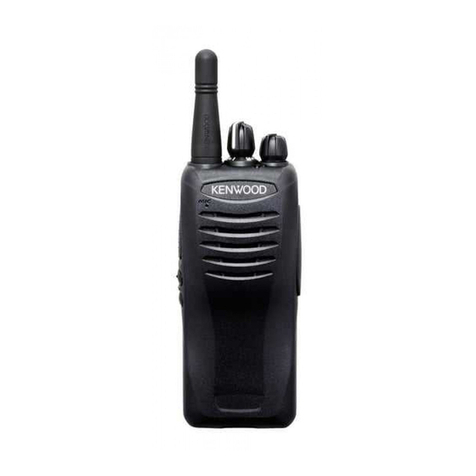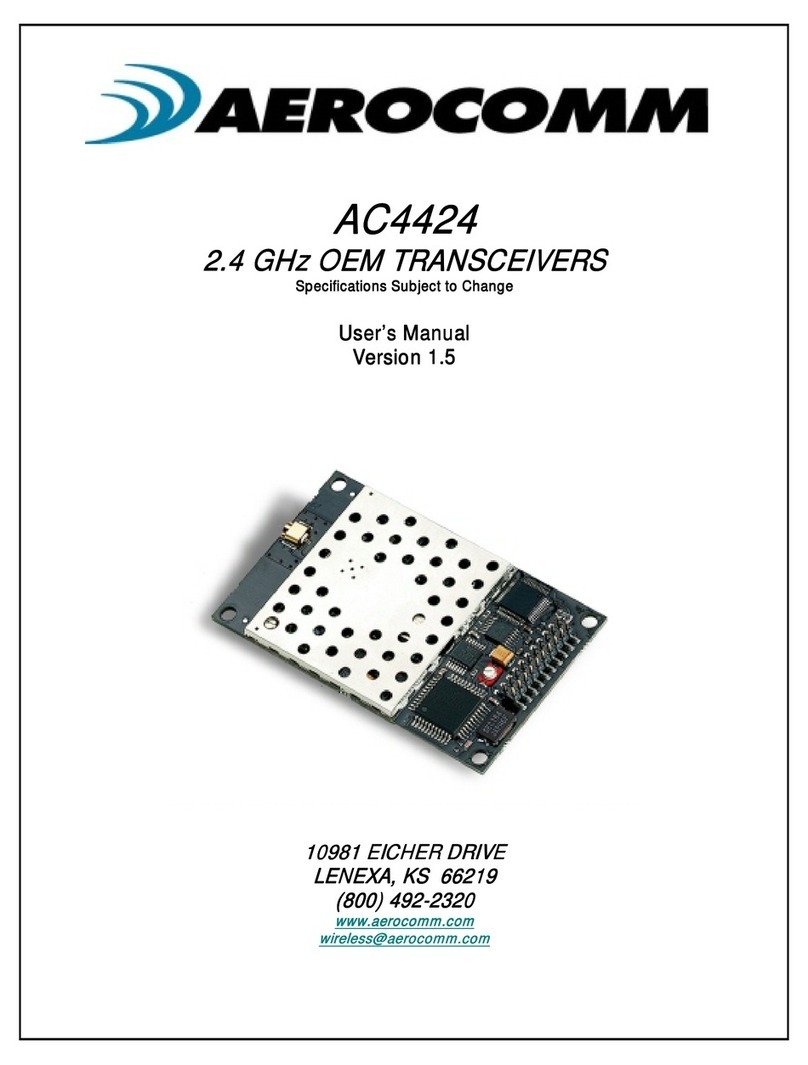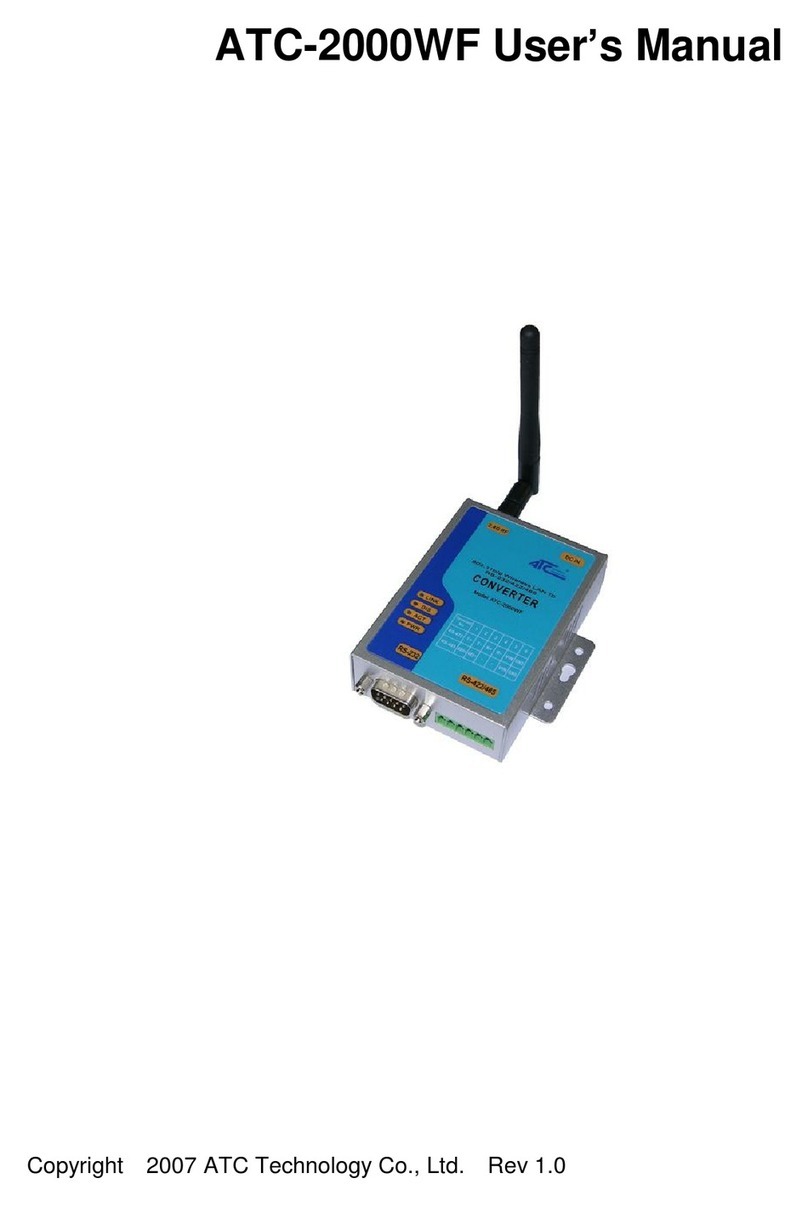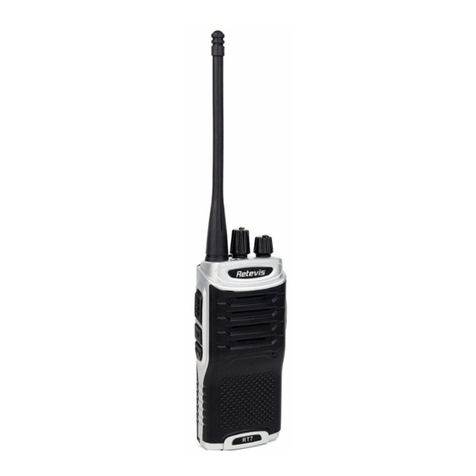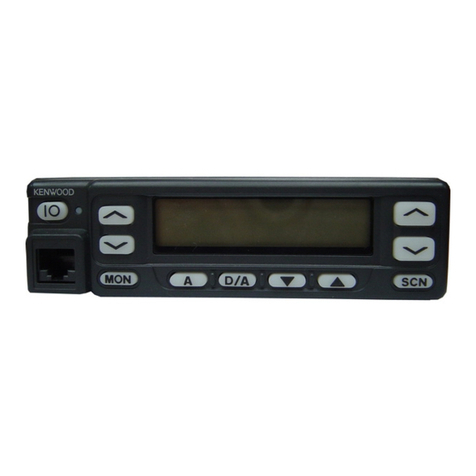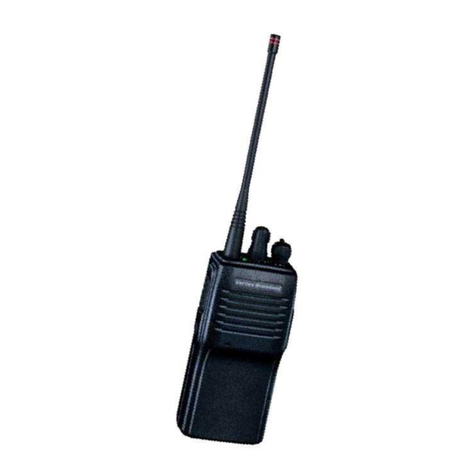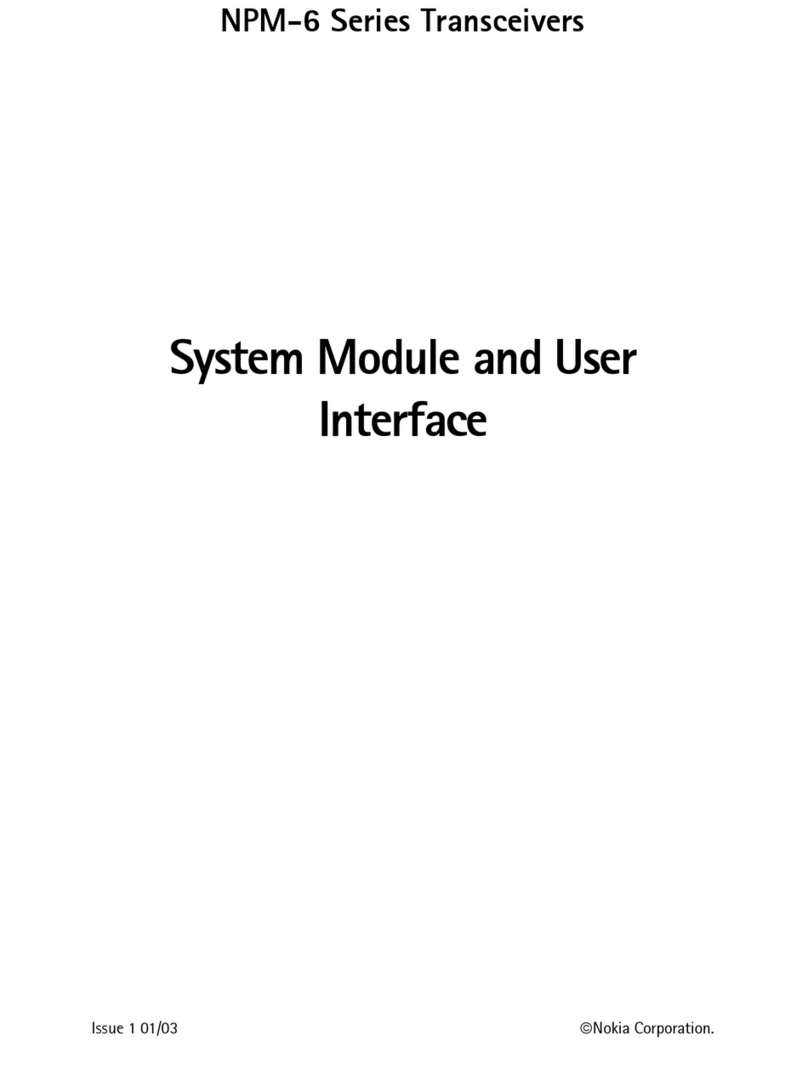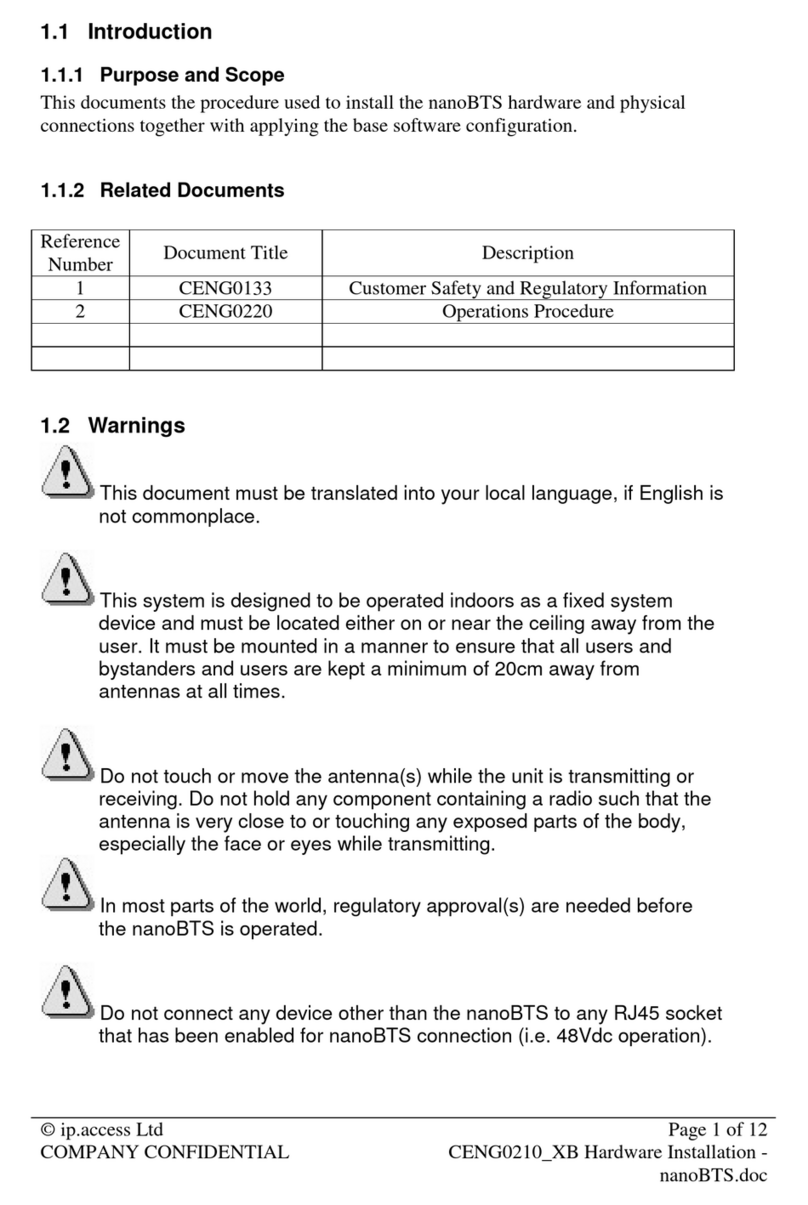Icom IC-7800 User manual

THE TRANSCEIVER
i7800
Instruction Manual
A-6328H-1EX-!5a
Printed in Japan
© 2004–2013 Icom Inc.

FOREWORD
i
Congratulations! You are the owner of the world’s most advanced amateur
HF/50 MHz transceiver— IC-7800. The IC-7800 is designed and built with
Icom’s superior technology and craftsmanship. With proper care, this prod-
uct should provide you with years of trouble-free operation.
We would like to take a few moments of your time to thank you for making
the IC-7800 your radio of choice, and hope you agree with Icom’s philos-
ophy of “technology first.” Many hours of research and development went
into the design of your IC-7800.
DFEATURES
❍Ultimate receiver performance: third-order intercept (IP3) of
+40 dBm (HF bands only), both main and sub
❍Independent identical receiver circuits for main and sub
bands provide perfect no-compromise Dualwatch operation
❍Built-in Baudot RTTY and PSK31 modulator/demodulator
and direct PC keyboard connection capability for RTTY and
PSK31 operation without a PC
❍Upgraded real-time spectrum scope— center frequency and
fix frequency modes, plus mini-scope displays
IMPORTANT
READ THIS INSTRUCTION MANUAL CAREFULLY before at-
tempting to operate the transceiver.
SAVE THIS INSTRUCTION MANUAL. This manual contains im-
portant safety and operating instructions for the IC-7800.
EXPLICIT DEFINITIONS
WORD DEFINITION
RDANGER! Personal death, serious injury or an explosion may occur.
RWARNING! Personal injury, fire hazard or electric shock may occur.
CAUTION Equipment damage may occur.
NOTE Recommended for optimum use. No risk of personal
injury, fire or electric shock.
TRADEMARKS
Icom, Icom Inc. and the Icom logo are registered trademarks of Icom In-
corporated (Japan) in Japan, the United States, the United Kingdom, Ger-
many, France, Spain, Russia and/or other countries.

ii
PRECAUTIONS
RDANGER HIGH RF VOLTAGE! NEVER
attach an antenna or internal antenna connector dur-
ing transmission. This may result in an electrical shock
or burn.
RWARNING! NEVER operate the transceiver
with a headset or other audio accessories at high vol-
ume levels. Hearing experts advise against continuous
high volume operation. If you experience a ringing in
your ears, reduce the volume or discontinue use.
RWARNING! NEVER operate or touch the
transceiver with wet hands. This may result in an elec-
tric shock or damage to the transceiver.
RWARNING! NEVER let metal, wire or other
objects protrude into the transceiver or into connec-
tors on the rear panel. This may result in an electric
shock.
RWARNING! Immediately turn the transceiver
power OFF and remove the power cable if it emits an
abnormal odor, sound or smoke. Contact your Icom
dealer or distributor for advice.
CAUTION: NEVER put the transceiver in any un-
stable place (such as on a slanted surface or vibrated
place). This may cause injury and/or damage to the
transceiver.
CAUTION: NEVER change the internal settings of
the transceiver. This may reduce transceiver perfor-
mance and/or damage to the transceiver.
In particular, incorrect settings for transmitter circuits,
such as output power, idling current, etc., might dam-
age the expensive final devices.
The transceiver warranty does not cover any problems
caused by unauthorized internal adjustment.
CAUTION: NEVER block any cooling vents on the
top, rear or bottom of the transceiver.
CAUTION: NEVER expose the transceiver to rain,
snow or any liquids.
CAUTION: NEVER install the transceiver in a
place without adequate ventilation. Heat dissipation
may be reduced, and the transceiver may be dam-
aged.
CAUTION: The line-voltage receptacle must be
near the transceiver and must be easily accessible.
Avoid extension cords.
CAUTION: The transceiver weighs approximately
25 kg (55 lb). Always have two people available to
carry, lift or turn over the transceiver.
DO NOT
use harsh solvents such as benzine or al-
cohol when cleaning, as they can damage the trans-
ceiver’s surfaces.
DO NOT push the PTT switch when you don’t actu-
ally desire to transmit.
DO NOT
use or place the transceiver in areas with
temperatures below ±0°C (+32°F) or above +50°C
(+122°F).
DO NOT
place the transceiver in excessively dusty
environments or in direct sunlight.
DO NOT
place the transceiver against walls or put-
ting anything on top of the transceiver. This may over-
heat the transceiver.
Always place unit in a secure place to avoid inadver-
tent use by children.
BE CAREFUL! If you use a linear amplifier, set the
transceiver’s RF output power to less than the linear
amplifier’s maximum input level, otherwise, the linear
amplifier will be damaged.
BE CAREFUL! NEVER touch the transceiver top
cover when transmitting continuously for long periods.
The top cover may be hot.
Use Icom microphones only (supplied or optional).
Other manufacturers’ microphones have different pin
assignments, and connection to the IC-7800 may dam-
age the transceiver or microphone.
The LCD display may have cosmetic imperfections
that appear as small dark or light spots. This is not a
malfunction or defect, but a normal characteristic of
LCD displays.
During maritime mobile operation, keep the trans-
ceiver and microphone as far away as possible from
the magnetic navigation compass to prevent errone-
ous indications.
Turn [I/O] switch (on the rear panel) OFF and/or dis-
connect the AC power cable from the AC outlet when
you will not use the transceiver for long period of
time.

qAC power cable*1������������� 1
wAntenna jumper cables ����������� 2
eRack mounting handles ��������� 1 pair
rScrews for rack mounting handles ���� 1 set
tCF (Compact Flash) memory card ������ 1
yStands ���������������� 1 pair
uSpare fuse (FGB 2 A)������������ 1
iRCA plugs ���������������� 2
oDC power plug��������������� 1
!0 2-conductor 1⁄8″plugs������������ 3
!1 3-conductor 1⁄8″plugs������������ 2
!2 3-conductor 1⁄4″plugs������������ 3
!3 ACC plugs (7-pin) ������������� 2
!4 ACC plugs (8-pin) ������������� 2
!5 Antenna connector caps ���������� 4
!6 Main dial*2���������������� 1
*1May differ from that shown depending on the version
*2
See the “Information—About the Main Dial” leaflet that
comes with the IC-7800, for dial attachment details.
iii
SUPPLIED ACCESSORIES
q
!0
!1 !2 !3 !4 !6!5
yu io
e
wr
t
FOR CLASS B UNINTENTIONAL RADIATORS
This equipment has been tested and found to comply with the limits for a Class B digital device, pursuant to part
15 of the FCC Rules. These limits are designed to provide reasonable protection against harmful interference in a
residential installation. This equipment generates, uses and can radiate radio frequency energy and, if not installed
and used in accordance with the instructions, may cause harmful interference to radio communications. However,
there is no guarantee that interference will not occur in a particular installation. If this equipment does cause harm-
ful interference to radio or television reception, which can be determined by turning the equipment off and on, the
user is encouraged to try to correct the interference by one or more of the following measures:
•Reorientorrelocatethereceivingantenna.
•Increasetheseparationbetweentheequipmentandreceiver.
•Connecttheequipmentintoanoutletonacircuitdifferentfromthattowhichthereceiverisconnected.
•Consultthedealeroranexperiencedradio/TVtechnicianforhelp.
FCC INFORMATION
CAUTION: Changes or modifications to this de-
vice, not expressly approved by Icom Inc., could void
your authority to operate this device under FCC reg-
ulations.

iv
Section 1 PANEL DESCRIPTION
■Front panel ������������������������ 1-2
■Rear panel ������������������������1-12
■Accessory connector information ��������������1-14
■LCD display������������������������1-15
■Screen menu arrangement �����������������1-16
Section 2 INSTALLATION AND CONNECTIONS
■Unpacking ������������������������ 2-2
■Antenna jumper cable connection �������������� 2-2
■Selecting a location �������������������� 2-2
■Rack mounting handle attachment �������������� 2-2
■Grounding ������������������������ 2-3
■Antenna connection �������������������� 2-3
■CF (Compact Flash) memory card �������������� 2-3
■Required connections ������������������� 2-4
DFront panel ����������������������� 2-4
DRear panel ����������������������� 2-4
■Advanced connections ������������������� 2-5
DFront panel ����������������������� 2-5
DRear panel—1 ��������������������� 2-5
DRear panel—2 ��������������������� 2-6
■Linear amplifier connections ���������������� 2-7
DConnecting the IC-PW1/EURO �������������� 2-7
DConnecting a non-Icom linear amplifier ����������� 2-7
■Transverter jack information����������������� 2-8
■FSKandAFSK(SSTV)connections ������������� 2-8
■Microphones (options) ������������������� 2-9
DSM-50 ������������������������� 2-9
DSM-30 ������������������������� 2-9
DHM-36 �������������������������2-10
■Microphone connector information ��������������2-10
Section 3 BASIC OPERATIONS
■When first applying power (CPU resetting) ���������� 3-2
■Initial settings ����������������������� 3-2
■Main/Sub band selection ������������������ 3-3
■SelectingVFO/memorymode ���������������� 3-3
■Selecting an operating band ���������������� 3-4
DUsing the band stacking registers ������������� 3-4
■Frequency setting ��������������������� 3-5
DTuning with the main dial ����������������� 3-5
DDirect frequency entry with the keypad ����������� 3-5
DQuick tuning step �������������������� 3-6
DSelecting “kHz” step ������������������� 3-6
D1⁄4tuning step function ������������������ 3-6
DSelecting 1 Hz step ������������������� 3-7
DAuto tuning step function ����������������� 3-7
■Operating mode selection������������������ 3-8
■Volumesetting ���������������������� 3-9
■RF gain adjustment �������������������� 3-9
■Squelch level adjustment ������������������ 3-9
■Meter indication selection������������������3-10
DMulti-function digital meter ����������������3-10
DMeter type selection �������������������3-11
■Basic transmit operation ������������������3-12
DTransmitting ����������������������3-12
DMicrophone gain adjustment ���������������3-12
TABLE OF CONTENTS

DDrive gain adjustment ������������������3-13
■Band edge warning beep ������������������3-13
DProgramming the user band edge �������������3-14
Section 4 RECEIVE AND TRANSMIT
■Operating SSB ���������������������� 4-2
DConvenient functions for receive�������������� 4-2
DConvenient functions for transmit ������������� 4-3
DAbout 5 MHz band operation (USA version only)������� 4-3
■Operating CW����������������������� 4-4
DConvenient functions for receive�������������� 4-4
DConvenient functions for transmit ������������� 4-5
DAbout CW reverse mode ����������������� 4-5
DAbout CW pitch control������������������ 4-5
DCW side tone function ������������������ 4-5
DAPF (Audio Peak Filter) operation ������������� 4-6
DAbout 137 kHz band operation
(Europe, UK, Italy, Spain, France versions only) ������� 4-6
■Electronic keyer functions������������������ 4-7
DMemory keyer screen ������������������ 4-8
DEditing a memory keyer ����������������� 4-9
DContest number set mode ����������������4-10
DKeyer set mode ���������������������4-11
■Operating RTTY (FSK) �������������������4-13
DConvenient functions for receive��������������4-14
DAbout RTTY reverse mode ����������������4-14
DTwin peak filter ���������������������4-14
DFunctions for the RTTY decoder indication ���������4-15
DSetting the decoder threshold level ������������4-15
DRTTY memory transmission ���������������4-16
DAutomatic transmission/reception setting ����������4-16
DEditing RTTY memory ������������������4-17
DRTTY decode set mode �����������������4-18
DData saving�����������������������4-20
■Operating PSK ����������������������4-21
DConvenient functions for receive��������������4-22
DAbout BPSK and QPSK mode���������������4-22
DFunctions for the PSK decoder indication ����������4-23
DSetting the decoder threshold level ������������4-23
DPSK memory transmission ����������������4-24
DAutomatic transmission/reception setting ����������4-24
DEditing PSK memory�������������������4-25
DPSK decode set mode ������������������4-26
DData saving�����������������������4-28
■Operating AM �����������������������4-29
DConvenient functions for receive��������������4-29
DConvenient functions for transmit �������������4-30
■Operating FM �����������������������4-31
DConvenient functions for receive��������������4-31
DConvenient functions for transmit �������������4-31
■Repeater operation ��������������������4-32
DRepeater tone frequency setting��������������4-32
■Tone squelch operation ������������������4-33
■Data mode (AFSK) operation ����������������4-34
v
TABLE OF CONTENTS

vi
Section 5 FUNCTIONS FOR RECEIVE
■Spectrum scope screen ������������������ 5-2
DCenter mode ���������������������� 5-2
DFix mode ������������������������ 5-3
DMini scope screen indication ��������������� 5-4
DScope set mode��������������������� 5-4
DUSB mouse operation ������������������ 5-9
■Preamplifier������������������������5-10
■Attenuator ������������������������5-10
■RIT function������������������������5-11
DRIT monitor function �������������������5-11
■AGC function �����������������������5-12
DSelecting the preset value ����������������5-12
DAdjusting the AGC time constant �������������5-12
DSetting the AGC time constant preset value���������5-12
■Twin PBT operation ��������������������5-13
■IF filter selection����������������������5-14
DIF filter selection���������������������5-14
DFilter passband width setting (except FM mode) �������5-14
DRoofing filter selection ������������������5-15
DDSP filter shape���������������������5-15
DFilter shape set mode ������������������5-15
■Dualwatch operation ��������������������5-17
■Noise blanker �����������������������5-18
DNB set mode ����������������������5-18
■Noise reduction ����������������������5-19
■Dial lock function ���������������������5-19
■Notch function�����������������������5-20
■Digital selector ����������������������5-20
■Audio scope screen ��������������������5-21
DAudio scope set mode ������������������5-22
Section 6 FUNCTIONS FOR TRANSMIT
■VOXfunction ����������������������� 6-2
DUsingtheVOXfunction ����������������� 6-2
DAdjustingtheVOXfunction ���������������� 6-2
DVOXsetmode ��������������������� 6-2
■Break-in function ��������������������� 6-3
DSemi break-in operation ����������������� 6-3
DFull break-in operation ������������������ 6-3
■∂TX function ����������������������� 6-4
D∂TX monitor function ������������������ 6-4
■Monitor function ���������������������� 6-4
■Transmit filter width setting (SSB only) ������������ 6-5
■Speech compressor (SSB only) ��������������� 6-5
■Split frequency operation ������������������ 6-6
■Quick split function��������������������� 6-7
DSplit lock function �������������������� 6-7
TABLE OF CONTENTS

Section 7 VOICE RECORDER FUNCTIONS
■Recording a QSO audio ������������������ 7-2
DTo start or stop recording����������������� 7-2
■Recording quick operation ����������������� 7-2
DTo start or stop recording����������������� 7-2
■Playing back recorded audio (QSO) ������������� 7-3
DBasic playing ���������������������� 7-3
DOperating while playing back ��������������� 7-4
■Deleting recorded audio file ����������������� 7-5
■Deleting recorded audio folder���������������� 7-5
■About digital voice recorder ����������������� 7-6
■Recording a received audio (Short REC) ����������� 7-7
DOne-touch recording ������������������� 7-7
■Playing back the recorded audio (Short REC) ��������� 7-7
DBasic playing ���������������������� 7-7
DOne-touch playing �������������������� 7-8
■Protect the recorded contents ���������������� 7-8
■Erasing the recorded contents���������������� 7-8
■Recording a message for transmit �������������� 7-9
DRecording ����������������������� 7-9
DConfirming a message for transmit������������� 7-9
■Programming a memory name ���������������7-10
■Sending a recorded message ����������������7-11
DSingle TX������������������������7-11
DRepeat TX �����������������������7-11
DTransmit level setting ������������������7-12
■Voicesetmode ����������������������7-12
■Saving a voice memory into the memory device ��������7-15
DSaving the received audio memory ������������7-15
DSaving the TX memory������������������7-15
Section 8 MEMORY OPERATION
■Memory channels ��������������������� 8-2
■Memory channel selection ����������������� 8-2
DUsing the [Y]/[Z] keys ������������������ 8-2
DUsing the keypad �������������������� 8-2
■Memory list screen��������������������� 8-3
DSelecting a memory channel using the memory list screen �� 8-3
DConfirming programmed memory channels ��������� 8-3
■Memory channel programming ��������������� 8-4
DProgramminginVFOmode ���������������� 8-4
DProgramming in memory mode �������������� 8-4
■Frequency transferring ������������������� 8-5
DTransferringinVFOmode ���������������� 8-5
DTransferring in memory mode ��������������� 8-5
■Memory names ���������������������� 8-6
DEditing (programming) memory names ����������� 8-6
■Memory clearing���������������������� 8-6
■Memo pads������������������������ 8-7
DWriting frequencies and operating modes into memo pads �� 8-7
DCalling up a frequency and operating mode from a memo pad� 8-7
Section 9 SCANS
■Scan types ������������������������ 9-2
■Preparation ������������������������ 9-2
■Voicesquelchcontrolfunction ���������������� 9-3
■Scan set mode ���������������������� 9-3
■Programmed scan operation ���������������� 9-4
vii
TABLE OF CONTENTS

viii
■∂F scan operation ��������������������� 9-4
■Fine programmed scan/∂F scan��������������� 9-5
■Memory scan operation ������������������ 9-6
■Select memory scan operation ��������������� 9-6
■Setting select memory channels ��������������� 9-7
DSetting in scan screen ������������������ 9-7
DSetting in memory list screen ��������������� 9-7
DErasing the select scan setting �������������� 9-7
■Tone scan ������������������������ 9-8
Section 10 ANTENNA TUNER OPERATION
■Antenna connection and selection ��������������10-2
■Antenna memory settings������������������10-3
DAntenna type selection ������������������10-3
DTemporary memory �������������������10-4
DAntenna selection mode �����������������10-4
■Antenna tuner operation ������������������10-5
DTuner operation ���������������������10-5
DIf the tuner cannot tune the antenna ������������10-6
Section 11 CLOCK AND TIMERS
■Time set mode ����������������������11-2
■Daily timer setting ���������������������11-3
■Setting sleep timer���������������������11-4
■Timer operation ����������������������11-4
Section 12 SET MODE
■Set mode description��������������������12-2
DSet mode operation �������������������12-2
DScreen arrangement �������������������12-3
■Level set mode ����������������������12-4
■ACC set mode ����������������������12-6
■Display set mode �������������������� 12-11
■Others set mode��������������������� 12-14
■CF/USB-MEMORY set menu ��������������� 12-27
DCF/USB-MEMORY set screen arrangement�������� 12-27
DSave option set mode ����������������� 12-28
DLoad option set mode ����������������� 12-29
■File saving ����������������������� 12-30
■File loading ����������������������� 12-31
■Changing the file name������������������ 12-32
■Deleting a file ���������������������� 12-33
■Formatting the memory device �������������� 12-33
■Unmounting the memory device �������������� 12-34
Section 13 MAINTENANCE
■Troubleshooting ����������������������13-2
DTransceiver power��������������������13-2
DTransmit and receive�������������������13-2
DScanning������������������������13-3
DDisplay�������������������������13-3
■Main dial brake adjustment �����������������13-3
■Voicesynthesizeroperation �����������������13-3
■SWR reading �����������������������13-4
■Screen type and font selections ���������������13-4
■Frequency calibration (approximate) �������������13-5
■Opening the transceiver’s case ���������������13-6
■Clock backup battery replacement ��������������13-6
TABLE OF CONTENTS

■Fuse replacement ���������������������13-7
■Resetting the CPU���������������������13-7
■About protection indications�����������������13-8
■Screen saver function �������������������13-8
Section 14 CONTROL COMMAND
■Remotejack(CI-V)information ���������������14-2
DCI-Vconnectionexample �����������������14-2
DData format�����������������������14-2
DCommand table ���������������������14-3
DData contents description���������������� 14-10
Section 15 SPECIFICATIONS AND OPTIONS
■Specifications �����������������������15-2
DGeneral ������������������������15-2
DTransmitter �����������������������15-2
DReceiver ������������������������15-3
DAntenna tuner����������������������15-3
■Options �������������������������15-4
Section 16 UPDATING THE FIRMWARE
■General �������������������������16-2
■Caution �������������������������16-2
■Preparation ������������������������16-3
DFirmware and firm utility �����������������16-3
DFile downloading ��������������������16-3
■Firmware update— Memory device �������������16-4
■Firmware update— PC �������������������16-6
DConnections ����������������������16-6
DIP address setting ��������������������16-7
DUpdating from the PC ������������������16-8
ix
TABLE OF CONTENTS

1-1
PANEL DESCRIPTION Section 1
■Front panel ������������������������ 1-2
■Rear panel ������������������������1-12
■Accessory connector information ��������������1-14
■LCD display������������������������1-15
■Screen menu arrangement �����������������1-16

1-2
■Front panel
qPOWER SWITCH [POWER] (p. 3-2)
➥Push to turn the transceiver power ON.
•The [POWER] indicator above this switch lights
green when powered ON.
➥Hold down for 1 second to turn the transceiver
power OFF.
•The[POWER]indicatorlightsorangewhenthetrans-
ceiver is OFF when the internal power supply is
switched ON.
wTRANSMIT SWITCH [TRANSMIT]
Selects transmitting or receiving.
•The[TX]indicatorlightsredwhiletransmittingandthe
[RX] indicator lights green when the squelch is open.
eANTENNA TUNER SWITCH [TUNER] (p. 10-5)
➥Turns the internal antenna tuner ON or OFF (by-
pass) when pushed momentarily.
•The[TUNER]indicatorabovethisswitchlightsgreen
when the tuner is turned ON, goes off when tuner is
turned OFF (bypassed).
➥Tunes the antenna tuner manually when held
down for 1 second.
•The[TUNER]indicatorblinksredduringmanualtun-
ing.
•Whenthetunercannottunetheantenna,thetuning
circuit is bypassed automatically after 20 seconds.
rTIMER SWITCH [TIMER] (p. 11-4)
➥Turns the sleep or daily timer function ON or
OFF.
•The[TIMER]indicatorabovethisswitchlightsgreen
when the timer is in use.
➥Enters timer set mode when held down for 1 sec-
ond.
tHEADPHONE JACK [PHONES]
Accepts standard stereo headphones.
•Outputpower:50mWwithan8Ωload.
•Whenheadphonesareconnected,theinternalspeaker
or connected external speaker does not function.
y
ELECTRONIC KEYER JACK [ELEC-KEY] (p. 2-4)
Accepts a paddle to activate the internal electronic
keyer for CW operation.
•Youcanselectinternalelectronickeyer,bug-keyor
straight key operation in keyer set mode. (p. 4-12)
•Astraightkeyjackislocatedontherearpanel.See
[KEY] on p. 1-13.
•Keyerpolarity(dotanddash)canbereversedinkeyer
set mode. (p. 4-12)
•4-channelmemorykeyerisavailableforyourconve-
nience. (p. 4-8)
(dot)
(com)
(dash)
uMICROPHONE CONNECTOR [MIC]
Accepts an optional microphone.
•Seep.15-4forappropriatemicrophones.
•Seep.2-10formicrophoneconnectorinformation.
1PANEL DESCRIPTION
q
w
e
r
t
y
u
io !0 !1 !2 !3
!
4
!
5
!
6
!
7
!
8
Turn the internal power supply ON in advance. The
internal power supply switch is located on the rear
panel. (p. 3-2)

1-3
iRF POWER CONTROL [RF PWR] (p. 3-12)
Continuously varies the RF output power from min-
imum (5 W*) to maximum (200 W*).
*AM mode: 5 W to 50 W
Increases
Decreases
oMIC GAIN CONTROL [MIC]
Adjusts microphone gain.
•ThetransmitaudiotoneinSSB,AMandFMmodescan
be adjusted independently in set mode. (p. 12-4)
✔How to set the microphone gain.
Set the [MIC] control so that the ALC meter swings within
the ALC range during normal voice level transmission in the
SSB or AM modes. (The ALC meter must be selected.)
Recommended level for
an Icom microphone
Decreases Increases
!0 VOX/BREAK-IN SWITCH [VOX/BK-IN]
➥PushtoturntheVOXfunctionONorOFFduring
SSB, AM and FM mode operation. (p. 6-2)
➥Push to turn the break-in function ON (semi-
break-in, full-break-in) or OFF during CW mode
operation. (p. 6-3)
➥Holddownfor1secondtoenterVOXsetmode.
(p. 6-2)
✔What is the VOX function?
TheVOXfunction(voiceoperatedtransmission)startstrans-
mission without pushing the transmit switch or PTT switch
when you speak into the microphone; then, automatically re-
turns to receive when you stop speaking.
✔What is the break-in function?
The break-in function switches transmit and receive with CW
keying. Full break-in (QSK) can monitor the receive signal
during keying.
!1 ELECTRONIC CW KEYER SPEED CONTROL
[KEY SPEED] (p. 4-4)
Adjusts the internal electronic CW keyer’s speed.
•6wpm(min.)to48wpm(max.)canbeset.
Max.
48 wpm
Min.
6 wpm
!2 BREAK-IN DELAY CONTROL [DELAY] (p. 6-3)
Adjusts the transmit-to-receive switching delay time
for CW semi-break-in operations.
Long delay for
slow speed keying
Short delay for
high speed keying
!3 MONITOR SWITCH [MONI] (p. 6-4)
Monitors your transmitted IF signal.
•TheCWsidetonefunctionsregardlessof[MONI]switch
setting in CW mode.
•The[MONI]indicatorabove thisswitch lightsgreen
while the function is activated.
!4 MEMORY CARD SLOT [CF CARD] (p. 2-3)
Insert the supplied CF (Compact Flash) memory
card for both reading/storing a wide variety of the
transceiver’s information and data.
•Theindicatorbesidetheslotlightsorblinkswhenthe
transceiver reads or writes to the memory card.
•Pushtheejectbuttontoremovethememorycard.
!5
MONITOR GAIN CONTROL [MONI GAIN] (p. 6-4)
Adjusts the transmit IF signal monitor level.
Monitor gain
decreases
Monitor gain
increases
Push
!6 COMPRESSION LEVEL CONTROL [COMP]
(p. 6-5)
Adjusts the speech compression level in SSB.
Compression
gain decreases
Compression
gain increases
Push
!7 DRIVE GAIN CONTROL [DRIVE] (p. 3-13)
Adjusts the transmitter level at the driver stage. Ac-
tivate in all modes (except SSB with [COMP] OFF).
Decreases
Increases
Push
!8 VOX GAIN CONTROL [VOX GAIN] (p. 6-2)
Adjusts the transmit/receive switching threshold
levelforVOXoperation.
Low
sensitivity
High
sensitivity
Push
1
PANEL DESCRIPTION

1-4
■Front panel (continued)
!9 AGC CONTROL [AGC] (for MAIN band; p. 5-12)
@0 AGC CONTROL [AGC] (for SUB band; p. 5-12)
Adjusts the continuously-variable AGC circuit time
constant.
•To use [AGC] control, push the appropriate band’s
[AGCVR]([AGCVR]indicatorlights).
Slow
Fast
@1 AGC VOLUME SWITCH [AGC VR]
(for MAIN band; p. 5-12)
@2 AGC VOLUME SWITCH [AGC VR]
(for SUB band; p. 5-12)
➥
Push to toggle [AGC] control usage ON or OFF.
•Use[AGC]control to set the AGC time constant
when switched ON.
•The [AGC VR] indicator above this switch lights
green when the control is ON.
➥Turns the AGC function OFF when held down for
1 second.
@3 AF CONTROL [AF] (inner control; for SUB band)
@4 AF CONTROL [AF] (inner control; for MAIN band)
Variesthe audiooutput level ofthe speaker or
headphones.
Audio output
increases
Audio output
decreases
@5 RF GAIN CONTROL [RF]
(outer control; for MAIN band; p. 3-9)
@6 RF GAIN CONTROL [RF]
(outer control; for SUB band; p. 3-9)
Adjusts the RF gain level.
While rotating the RF gain control, you may hear
noise. This comes from the DSP unit and does
not indicate a malfunction.
Sensitivity
increases
Sensitivity
decreases
@7 SQUELCH CONTROL [SQL]
(outer control; for MAIN band; p. 3-9)
@8 SQUELCH CONTROL [SQL]
(outer control; for SUB band; p. 3-9)
Adjusts the squelch threshold level. The squelch re-
moves noise output from the speaker (closed con-
dition) when no signal is received.
•ThesquelchisparticularlyeffectiveforFM.Itisalso
available for other modes.
•11to12o’clockpositionisrecommendedforanyset-
ting of the [SQL] control.
Deep
Deep
S-meter
squelch
Noise squelch
Squelch
is open.
Squelch
threshold
Shallow Shallow
1PANEL DESCRIPTION
@6
@4
@5
@1
@2
@3
#
2
!9
#0 #1@9
@0
#
3
#
4
@7 @8

1-5
@9 MULTI-FUNCTION SWITCHES
Push to select the functions indicated in the LCD
display to the right of these switches.
•Functionsvarydependingontheoperatingcondition.
➥Selects the antenna connector from
ANT1, ANT2, ANT3 or ANT4 when
pushed. (p. 10-2)
➥Displays antenna selection memory
when held down for 1 second.
•Whenthereceiveantennaisactivated,the
antenna which is connected to [ANT4] is
used for receive only.
When a transverter is in use, this [ANT]
doesnotfunctionand‘TRV’appears.
➥Selects RF power (Po), SWR, ALC,
COMP,Vdor Idmetering during trans-
mit. (p. 3-10)
➥Switches the multi-function digital meter
ON or OFF when held down for 1 sec-
ond. (p. 3-10)
➥Selects one of 2 receive RF preamps or
bypasses them. (p. 5-10)
•“P.AMP1”activates10dBpreamp.
•
“P. AMP2” activates 16 dB high-gain preamp.
✔What is the preamp?
The preamp amplifies received signals in the front end cir-
cuit to improve S/N ratio and sensitivity. Select “P. AMP1” or
“P. AMP2” when receiving weak signals.
➥Selects 6 dB, 12 dB or 18 dB attenuator
when pushed. (p. 5-10)
➥Selects 3 dB, 6 dB, 9 dB, 12 dB, 18 dB,
or 21 dB attenuator when held down for
1 second. (p. 5-10)
✔What is the attenuator?
The attenuator prevents a desired signal from distorting
when very strong signals are near the desired frequency, or
when very strong electric fields, such as from a broadcasting
station, are near your location.
➥Activates and selects fast, middle or slow
AGC time constant when pushed. (p.
5-12)
•InFMmode,only“FAST”isavailable.
➥Enters the AGC set mode when held
down for 1 second. (p. 5-12)
AGC time constant can be set between 0.1 to 8.0
second (depends on mode), or turned OFF. When
AGC is “OFF,” the S-meter does not function.
✔What is the AGC?
The AGC controls receiver gain to produce a constant audio
output level, even when the received signal strength varies
dramatically. Select “FAST” for tuning and then select “MID”
or “SLOW” depending on the receiving condition.
➥Turns the speech compressor ON or
OFF in SSB mode. (p. 6-5)
➥Switches the narrow, middle or wide
compression when held down for 1 sec-
ond.
✔What is the speech compressor?
The speech compressor compresses the transmitter audio
input to increase the average audio output level, to increase
talk power. This function is effective for long-distance com-
munication or when propagation conditions are poor.
➥Turns the 1⁄4-speed tuning function ON
or OFF in SSB data, CW, RTTY and
PSK modes. (p. 3-6)
•
1⁄4function sets dial rotation to 1⁄4of normal
speed for fine tuning.
➥Switches between the tone encoder,
tone squelch function and no-tone oper-
ation when pushed in FM mode. (pp.
4-32, 4-33)
➥Enters the tone set mode when held
down for 1 second in FM mode. (pp.
4-32, 4-33)
➥Switches the voice squelch control func-
tion ON or OFF; useful for scanning. (p.
9-3)
#0 TRANSMIT INDICATOR [TX] (for MAIN band)
#1 TRANSMIT INDICATOR [TX] (for SUB band)
Lights red while transmitting.
•SUBband’s[TX]indicatorlightsonlywheninsplitoper-
ation.
#2 ANTI VOX CONTROL [ANTI VOX] (p. 6-2)
AdjuststheVOXdeactivateleveltopreventun-
wantedVOXactivationfromthespeakeraudio.
Decreases
cut-off level
Increases
cut-off level
Push
#3 LCD CONTRAST CONTROL [CONTRAST]
Adjusts the LCD contrast.
Low
contrast
High
contrast
Push
#4 LCD BRIGHTNESS CONTROL [BRIGHT]
Adjusts the LCD brightness.
Dark
Bright
Push
1
PANEL DESCRIPTION

1-6
■Front panel (continued)
#5
NOISE REDUCTION SWITCH [NR]
(for MAIN band;
p. 5-19)
#6 NOISE REDUCTION SWITCH [NR] (for SUB band;
p. 5-19)
Push to switch the DSP noise reduction ON or
OFF.
•The[NR]indicatorabovethisswitchlightsgreenwhen
the function is activated.
#7 NOISE REDUCTION LEVEL CONTROL [NR]
(inner control; for SUB band; p. 5-19)
#8 NOISE REDUCTION LEVEL CONTROL [NR]
(inner control; for MAIN band; p. 5-19)
Adjusts the DSP noise reduction level when the
noise reduction is in use. Set for maximum read-
ability.
•Tousethiscontrol,pushtheappropriateband’s[NR].
Increases
Decreases
#9 NOISE BLANKER CONTROL [NB] (outer control;
for MAIN band; p. 5-18)
$0 NOISE BLANKER CONTROL [NB] (outer control;
for SUB band; p. 5-17)
Adjust the noise blanker threshold level.
•To use this control, push appropriate band’s [NB]
switch.
Deep
Shallow
$1 NOISE BLANKER SWITCH [NB] (for MAIN band;
p. 5-18)
$2 NOISE BLANKER SWITCH [NB] (for SUB band;
p. 5-18)
➥Switches the noise blanker ON or OFF when
pushed. The noise blanker reduces pulse-type
noise such as that generated by automobile ig-
nition systems. This function cannot be used for
FM, or non-pulse-type noise.
•The[NB] indicatorabovethis switchlights green
while the function is activated.
➥Enters blank-width set mode when held down for
1 second.
$3 RECEIVE INDICATOR [RX] (for MAIN band)
$4 RECEIVE INDICATOR [RX] (for SUB band)
Lights green while receiving a signal and when the
squelch is open.
$5
LOCK INDICATOR [LOCK] (for MAIN band; p. 5-19)
$6
LOCK INDICATOR [LOCK] (for SUB band; p. 5-19)
Lights when the dial lock function is activated.
$7 SPLIT OPERATION INDICATOR [SPLIT]
Lights during split frequency operation.
$8 LCD FUNCTION DISPLAY (p. 1-15)
Shows the operating frequency, function switch
menus, spectrum scope screen, memory channel
screen, set mode settings, etc.
1PANEL DESCRIPTION
#5
#6
$1 $2
#8
#9
$5$3 $6 $9$4$7 $8
#7
$0
%
0
%
1
%
3
%
4
%
6
%
2
%
5

1-7
$9 MEMORY UP/DOWN SWITCHES [Y]/[Z](p. 8-2)
Push to select the desired memory channel.
•MemorychannelscanbeselectedbothinVFOand
memory modes.
%0 LCD FUNCTION SWITCHES [F-1]–[F-7]
Push to select the function indicated in the LCD dis-
play above these switches.
•Functionsvarydependingontheoperatingcondition.
%1 MODE SWITCHES
Selects the desired mode. (p. 3-8)
•Announcesselectedmodeviathespeechsynthesizer.
(p. 12-17)
➥
Selects USB or LSB modes alternately.
➥Selects CW or CW-R (CW reverse) modes
alternately.
➥Switches between RTTY and PSK
mode.
➥Switches RTTY or RTTY-R (RTTY re-
verse) mode when held down for 1 sec-
ond in RTTY mode.
➥Switches PSK or PSK-R (PSK reverse)
mode when held down for 1 second in
PSK mode.
➥Selects AM or FM modes alternately.
➥Selects SSB, AM or FM data mode
(USB-D, LSB-D, AM-D, FM-D) when
pushed in SSB, AM or FM mode, re-
spectively.
➥Switches D1, D2 or D3 when held down
for 1 second.
%2 MINI SPECTRUM SCOPE SWITCH [M.SCOPE]
(p. 5-4)
➥Push to t
urn ON or OFF the mini spectrum scope
screen.
•Theminispectrumscopescreencanbedisplayed
with another screen, such as memory or set mode
screen, simultaneously.
➥Hold down for 1 second to t
urn ON the spectrum
scope screen.
%3 VOICE MEMORY RECORD SWITCH [REC]
➥Push to store the previous received signal for the
preset time period. (p. 7-7)
•Thepresettimeperiodcanbesetinthevoiceset
mode. (p. 7-13)
➥Hold down for 1 second to record a QSO (Com-
munication) audio onto a memory device. (p.
7-2)
•Holddownthisswitchfor1secondagaintostopre-
cording.
•Therecordedmemorydevicecanbechangedinthe
voice set mode. (p. 7-13)
%4 VOICE MEMORY PLAY BACK SWITCH [PLAY]
(p. 7-8)
➥
Push to playback the selected voice memory in
the RX memory screen for the preset time period.
•WhentheRXmemoryscreenisnotdisplayed,the
previously recorded audio is played back for the
preset time period.
➥Hold down for 1 second to playback all of the se-
lected voice memory in the RX memory screen.
•WhentheRXmemoryscreenisnotdisplayed,allof
the previously recorded audio is played back.
%5 EXIT/SET SWITCH [EXIT/SET]
➥Push to exit, or return to the previous screen in-
dication during spectrum scope, memory, scan
or set mode screen display.
➥Displays set mode menu screen when held down
for 1 second.
%6 TRANSMIT FREQUENCY CHECK SWITCH [XFC]
(p. 6-6)
Monitors the transmit frequency (including ∂TX fre-
quency offset) when held down during split frequency
operation.
•Whileholdingdownthisswitch,thetransmitfrequency
can be changed with the main dial, keypad, memo pad
or [Y]/[Z] switches.
•WhenthesplitlockfunctionisturnedON,pushing[XFC]
cancels the dial lock function. (p. 6-7)
1
PANEL DESCRIPTION

1-8
■Front panel (continued)
%7 MEMO PAD-WRITE SWITCH [MP-W] (p. 8-7)
Programs the selected readout frequency and oper-
ating mode into a memo pad.
•The5mostrecententriesremaininmemopads.
•Thememopadcapacitycanbeexpandedfrom5to10
in set mode. (p. 12-18)
%8 VFO/MEMORY SWITCH [V/M]
➥Switches the selected readout operating mode
betweentheVFOandmemorywhenpushed.
(pp. 3-3, 8-2)
➥TransfersthememorycontentstoVFOwhen
held down for 1 second. (p. 5-5)
%9 KEYPAD
➥Pushing a key selects the operating band.
•[GENE•.]selectsthegeneralcoverageband.
➥Pushing the same key 2 or 3 times calls up other
stacked frequencies in the band. (p. 3-4)
•Icom’striplebandstackingregistermemorizes3fre-
quencies in each band.
➥Afterpushing[F-INP•e n t ], enters a frequency or
memorychannel.Pushing[F-INP•e n t ] or [Y/[Z]
is necessary to end. (pp. 3-5, 8-2)
•e.g.toenter14.195MHz,push[F-INP][1.8•1][10•4]
[GENE•][1.8•1][28•9][14•5][F-INP•e n t ].
^0 MEMORY WRITE SWITCH [MW] (p. 8-4)
Stores the selected readout frequency and operat-
ing mode into the displayed memory channel when
held down for 1 second.
•ThisfunctionisavailablebothinVFOandmemory
modes.
^1 MEMO PAD-READ SWITCH [MP-R] (p. 8-7)
Each push calls up a frequency and operating
mode in a memo pad. The 5 (or 10) most recently
programmed frequencies and operating modes can
be recalled, starting from the most recent.
•Thememopadcapacitycanbeexpandedfrom5to10
in set mode. (p. 12-18)
^2
FILTER SWITCH [FILTER] (for MAIN band; p. 5-14)
^3
FILTER SWITCH [FILTER] (for SUB band; p. 5-14)
➥Selects one of 3 IF filter settings.
➥Enters the filter set screen when held down for 1
second.
^4 AUDIO PEAK FILTER/TWIN PEAK FILTER
SWITCH [APF/TPF] (for MAIN band)
^5 AUDIO PEAK FILTER/TWIN PEAK FILTER
SWITCH [APF/TPF] (for SUB band)
➥Push to turn the audio peak filter ON or OFF dur-
ing CW mode operation. (p. 4-6)
➥Push to turn the twin peak filter ON or OFF dur-
ing RTTY mode operation. (p. 4-14)
•“ ” appears when audio peak filter is in use.
•“ ” appears when twin peak filter is in use.
➥During CW mode operation, hold down for 1 sec-
ond to select the APF passband width from 80,
160 and 320 Hz. (p. 4-6)
1PANEL DESCRIPTION
%7 %8 ^0 ^1%9
&
0
&
8
&
1
&
5
&
4
&
2
&
6
&
3
&
7
&
9
^2 ^3
^5
^4
^6
^7
^9
^8

1-9
^6
NOTCH SWITCH [NOTCH] (for SUB band; p. 5-20)
^7
NOTCH SWITCH [NOTCH] (for MAIN band; p. 5-20)
➥Switches the notch function between auto, man-
ual or OFF in SSB and AM modes.
➥Turns the manual notch function ON or OFF
when pushed in CW, RTTY and PSK31 mode.
➥Turns the auto notch function ON or OFF when
pushed in FM mode.
•“ ” appears when auto notch is in use.
•“ ” appears when manual notch is in use.
➥Switches the manual notch characteristics from
wide, middle or narrow when held down for 1
second.
✔What is the notch function?
The notch function eliminates unwanted CW or AM carrier
tones while preserving the desired voice signal. The DSP
circuit automatically adjusts the filtering frequency to effec-
tively eliminate unwanted tones.
^8 DUALWATCH SWITCH [DUALWATCH] (p. 5-17)
➥Turns the dualwatch function ON or OFF when
pushed.
➥Turns the dualwatch function ON, and equalizes
the main/sub readout frequency to the sub/main
readout when held down for 1 second. (Quick du-
alwatch function)
•ThequickdualwatchfunctioncanbeturnedOFF
using set mode. (p. 12-15)
^9 SPLIT SWITCH [SPLIT] (p. 6-6)
➥Push to turn ON or OFF the split function.
➥Hold down for 1 second to turn the split function
ON and equalizes the sub readout frequency to
the main readout in non-FM modes, and then
sets the sub readout for frequency input mode.
(Quick split function)
•IntheFMmode,thesubreadoutfrequencyisshifted
the preset frequency offset from the main readout
frequency. (pp. 12-15, 12-16)
•ThequicksplitfunctioncanbeturnedOFFusingset
mode. (p. 12-15)
➥After inputting a frequency offset, push to turn
the split function ON, and the sub readout fre-
quency is shifted the amount of frequency from
the main readout frequency.
&0 MAIN BAND ACCESS SWITCH [MAIN]
Selects the main readout.
•Themainreadoutfrequencyisclearlydisplayed.The
sub readout functions only during split operation or du-
alwatch.
&1 MAIN/SUB EQUALIZING SWITCH [M=S]
Hold down for 1 second to equalize the sub readout
frequency to the main readout frequency.
&2 AUTOMATIC TUNING SWITCH [AUTO TUNE]
(for MAIN band)
&3 AUTOMATIC TUNING SWITCH [AUTO TUNE]
(for SUB band)
Turns the automatic tuning function ON or OFF in
CW and AM modes.
&4 MAIN DIAL
Changes the displayed frequency (main band), se-
lects set mode setting, etc.
&5 MAIN/SUB CHANGE SWITCH [CHANGE]
Switches the frequency and selected memory chan-
nel between main and sub readouts when pushed.
•
Switches between transmit frequency and receive fre-
quency when the split frequency function is ON. (p. 6-6)
&6 LOCK SWITCH [LOCK] (for MAIN band; p. 5-19)
&7 LOCK SWITCH [LOCK] (for SUB band; p. 5-19)
Push to switch the dial lock function ON or OFF.
&8 SUB BAND ACCESS SWITCH [SUB]
Selects the sub readout.
•Thesubreadoutfrequencyisclearlydisplayed.The
main readout functions only during split operation or du-
alwatch.
&9 SUB DIAL
Changes the displayed frequency in sub band.
1
PANEL DESCRIPTION
IMPORTANT!
When receiving a weak signal, or receiving a signal
with interference, the automatic tuning function may
tune the receiver to an undesired signal.

1-10
■Front panel (continued)
*0 RIT/∂TX CONTROL [RIT/∂TX] (pp. 5-11, 6-4)
Shifts the receive and/or transmit frequency without
changing the transmit and/or receive frequency.
•Rotatethecontrolclockwisetoincreasethefrequency,
or rotate the control counterclockwise to decrease the
frequency. The RIT or ∂TX functions must be ON.
•Theshiftfrequencyrangeis±9.999kHzin1Hzsteps
(or ±9.99 kHz in 10 Hz steps).
Frequency
increases
Frequency
decreases
*1 PASSBAND TUNING CONTROLS [TWIN PBT]
(for MAIN band; p. 5-13)
*2 PASSBAND TUNING CONTROLS [TWIN PBT]
(for SUB band; p. 5-13)
Adjusts the receiver’s IF filter “passband width” via
the DSP.
•Passbandwidthandshiftfrequencyaredisplayedinthe
multi-function display.
•
Hold down [PBT CLEAR] for 1 second to clear the PBT
settings.
•Theadjustmentrangeishalfofthepassbandwidth,
and the value is adjustable in 25 Hz steps for the SSB/
CW/RTTY/PSK modes, and 100 Hz steps for the AM
mode.
✔What is the PBT control?
The PBT function electronically modifies the IF passband
width to reject interference. This transceiver uses the DSP
circuit for the PBT function.
PBT2
PBT1
Low cutHigh cut Center
–+
*3 PBT CLEAR SWITCH [PBT CLEAR]
(for MAIN band; p. 5-13)
*4 PBT CLEAR SWITCH [PBT CLEAR]
(for SUB band; p. 5-13)
Clears the PBT settings when held down for 1 sec-
ond.
•The[PBTCLEAR]indicatorabovethisswitchlights
when PBT is in use.
1PANEL DESCRIPTION
*0
(
5
(
6
(
7
(
8
*3*1 *2*4
*8
*7
*9
(0
(2
(3
(4
*6
*5
(1
Other manuals for IC-7800
10
Table of contents
Other Icom Transceiver manuals
